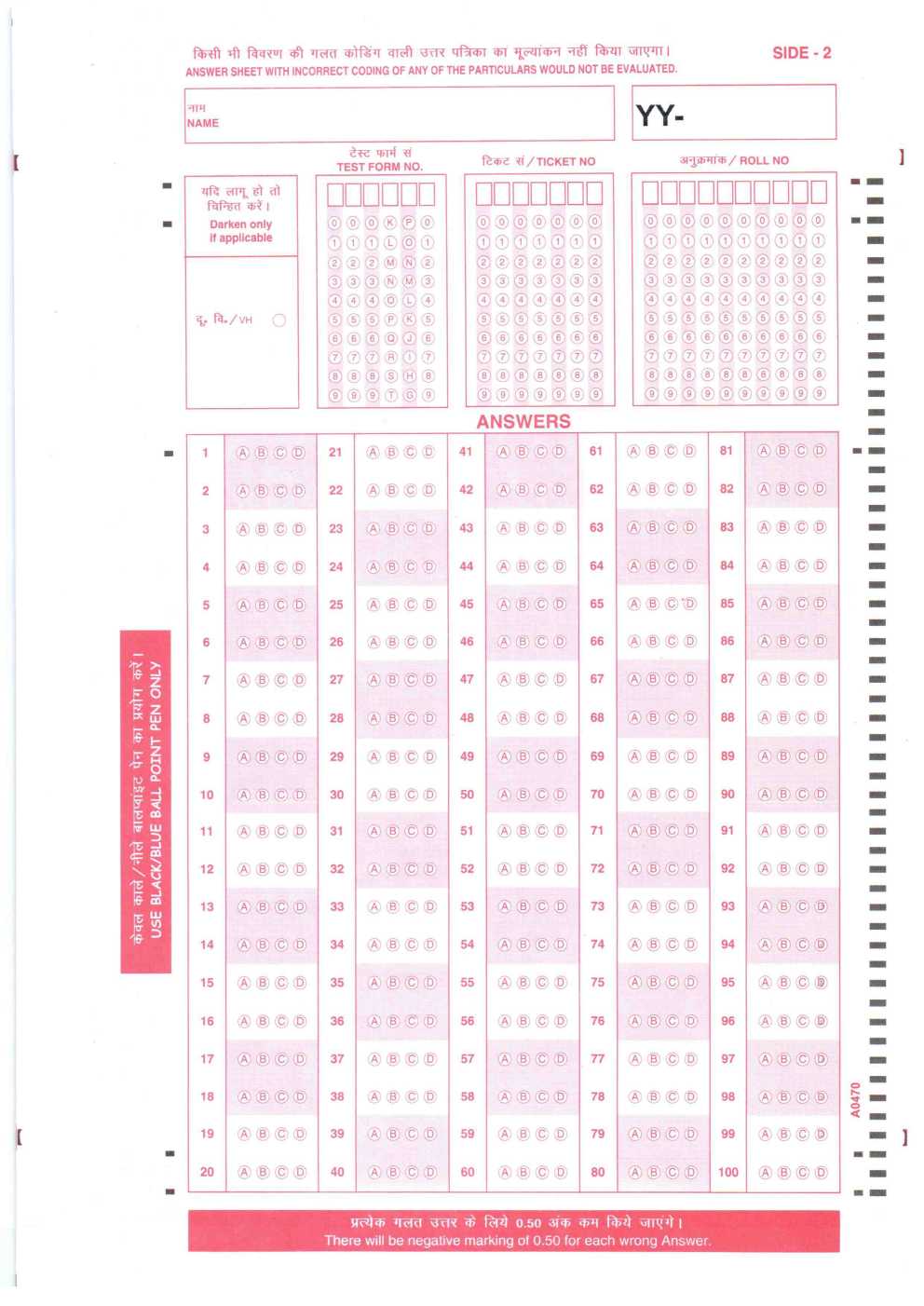|
#2
2nd April 2016, 03:40 PM
| |||
| |||
| Re: OMR Sheet for SSC CGL
Staff Selection Commission (SSC) conducts combined Graduate Level (CGL) competitive exam which is conducted in three stages. The Examination can be divided into 3 tiers, which are:- -Combined Graduate Level (Preliminary) Examination (Tier-1) -Combined Graduate Level (Main) Examination (Tier-2) -Personality Test/Interview As per your demand here I am providing you OMR Sheet (II ND 100 Resp Sheet) for SSC CGL Tier –II OMR Sheet (II ND 100 Resp Sheet) for SSC CGL Tier –II   Syllabus of SSC CGL Tier –II Paper – I Quantitative Ability: -Number Systems -Computation of Whole Numbers -Decimals and Fractions -Fundamental Arithmetical Operations -Percentage, Ratio and Proportion -Average and Interest -Profit and Loss, Discount -Use of Table and Graphs -Mensuration, Time and Distance -Ratio and Time etc Paper – II English Language & Comprehension: -Error recognition -Filling blanks with appropriate verbs -Preposition, Articles -Vocabulary, Spellings -Grammar -Sentence Structure and Sentence Completion etc Paper III Statistics for Investigator Grade-II Collection Classification and Presentation of Statistical Data: Primary and Secondary data, Methods of data collection; Tabulation of data; Graphs and charts; Frequency distributions; Diagrammatic presentation of frequency distributions. Measures of Central Tendency: Common measures of central tendency mean median andmode; Partition values- quartiles, deciles, percentiles. Measures of Dispersion: Common measures dispersion – range, quartile deviations, mean deviation and standard deviation; Measures of relative dispersion. Moments, Skewness and Kurtosis: Different types of moments and their relationship; meaning of skewness and kurtosis; different measures of skewness and kurtosis. Correlation and Regression: Scatter diagram; simple correlation coefficient; simple regression lines; Spearman’s rank correlation; Measures of association of attributes; Multiple regression; Multiple and partial correlation (For three variables only). Probability Theory – Meaning of probability; Different definitions of probability; Conditional probability; Compound probability; Independent events; Bayes’ theorem. Random Variable and Probability Distributions – Random variable; Probability functions; Expectation and Variance of a random variable; Higher moments of a random variable; Binomial , Poisson, Normal and Exponential distributions; Joint distribution of two random variable (discrete). Sampling Theory – Concept of population and sample; Parameter and statistic, Sampling and non-sampling errors; Probability and non-probability sampling techniques(simple randomsampling, stratified sampling, multistage sampling, multiphase sampling, cluster sampling, systematic sampling, purposive sampling, convenience sampling and quota sampling); Sampling distribution(statement only); Sample size decisions. Statistical Inference – Point estimation and interval estimation, Properties of a good estimator, Methods of estimation (Moments method, Maximum likelihood method, Least squares method), Testing of hypothesis, Basic concept of testing, Small sample and large sample tests, Tests based on Z, t, Chi-square and F statistic, Confidence intervals. Analysis of Variance – Analysis of one-way classified data and two-way classified data. Time Series Analysis – Components of time series, Determinations of trend component by different methods, Measurement of seasonal variation by different methods. Index Numbers – Meaning of Index Numbers, Problems in the construction of index numbers, Types of index number, Different formulae, Base shifting and splicing of index numbers, Cost of living Index Numbers, Uses of Index Numbers. Paper IV: General Studies (Finance and Economics) for the post of Assistant Audit Officer in Indian Audit & Accounts Department under CAG Part A: Finance and Accounts Fundamental principles and basic concept of Accounting: Financial Accounting: Nature and scope, Limitations of Financial Accounting, Basic concepts and Conventions, Generally Accepted Accounting Principles. Basic concepts of accounting : Single and double entry, Books of original Entry, Bank Reconciliation, Journal, ledgers, Trial Balance, Rectification of Errors, Manufacturing, Trading, Profit & loss Appropriation Accounts, Balance Sheet Distinction between Capital and Revenue Expenditure, Depreciation Accounting, Valuation of Inventories, Non-profit organizations Accounts, Receipts and Payments and Income & Expenditure Accounts, Bills of Exchange, Self Balancing Ledgers. Part B: Economics and Governance -Comptroller & Auditor General of India- Constitutional provisions, Role and responsibility. -Finance Commission-Role and functions. -Basic Concept of Economics and introduction to Micro Economics Definition, scope and nature of Economics, Methods of economic study and Central problems of an economy and Production possibilities curve. -Theory of Demand and Supply Meaning and determinants of demand, Law of demand and Elasticity of demand, Price, income and cross elasticity; Theory of consumer’s behaviour-Marshallian approach and Indifference curve approach, Meaning and determinants of supply, Law of supply and Elasticity of Supply. -Theory of Production and cost Meaning and Factors of production; Laws of production- Law of variable proportions 22 and Laws of returns to scale. -Forms of Market and price determination in different markets Various forms of markets-Perfect Competition, Monopoly, Monopolistic Competition and Oligopoly ad Price determination in these markets. -Indian Economy Nature of the Indian Economy Role of different sectors-Role of Agriculture, Industry and Services-their problems and growth; National Income of India-Concepts of national income, Different methods of measuring national income -Population -Its size, rate of growth and its implication on economic growth Poverty and unemployment- Absolute and relative poverty, types, causes and incidence of unemployment Infrastructure-Energy, Transportation, Communication. -Economic Reforms in India Economic reforms sice 1991; Liberalisation, Privatisation, Globalization and Disinvestment. -Money and Banking Monetary/ Fiscal policy- Role and functions of Reserve Bank of India; functions of commercial Banks/RRB/Payment Banks Budget and Fiscal deficits and Balance of payments Fiscal Responsibility and Budget Management Act, 2003. -Role of Information Technology in Governance |